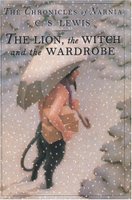This is the first-written and most famous of the Narnia books. It's not my favorite of the Chronicles, in part because of its popularity; it bothers me a little bit that so many people have only read this book, and not any of the other Chronicles of Narnia (they are missing out on so much!). However, I have to admit that it is actually worth their time; they should at least read this one, even if they don't get around to the others. It is actually better, and deeper than I remembered.
I seemed to pay better attention to the details of the book this time through; perhaps that is because I knew I would be discussing it with others, and maybe also because I'm imagining the movie and wondering how they will handle certain things.
One detail I thought was odd was the narrator's insistence on the wisdom of not shutting a wardrobe door on oneself-- it's mentioned more than once, and seems to be one way of differentiating the common sense that both Lucy and Peter have, but which Edmund is notably lacking. Wardrobes are a bit less common these days, or at least in the States, so it seems like an odd concern, although I imagine there might not be a latch or door knob on the inside of one, so it would be easy to get stuck if you unwisely let the door latch when you are inside... It's a small point, but it struck me as rather odd.
I also paid more attention to the whole scene of Aslan's sacrifice for Edmund. I don't know if I've never really noticed it before (it seems so obvious that I must have, but I don't distinctly remember), but the parallels with Christ's death and resurrection are pretty detailed. For instance, Lucy & Susan are the only ones who sense Aslan's mood and follow him, and then walk with him as he goes back to the Stone Table, and then watch the whole scene from the safety of the woods-- just as the women were the ones who were actually present at the crucifixion, while the men were off hiding. (Why is that? Were male disciples considered more dangerous? Did the authorities not even consider the possibility that women would also be followers?) Likewise, the Witch's party jeers and taunts Aslan, calling him "puss" and such-- just as the Roman soldiers taunted Christ. One interesting difference here is that the dark creatures of Narnia are well aware of Aslan's strength and powers (although they underestimate the depth of those powers), and are afraid of him until they have thoroughly bound him. I think that in Christ's case, the soldiers, at least when they were taunting and manhandling him, did not believe he had any power over them. I also noticed Jadis calling Aslan a fool, and saying that once she has killed him, she will then kill Edmund and cement her rule over all of Narnia. This struck a chord with me, because so often the wisdom of God is foolishness to us; it is not logical, according to the rules we know-- because we are not acquainted with the "deeper magic from before the dawn of time".
Some of the descriptions are very colorful, and will be exciting to see on the big screen in the theater-- in particular the resurrection of Aslan, and then when Aslan breathes new life into all the creatures the White Witch has turned into statues. When Lucy & Susan are staring out at the sea and Cair Paravel, before they know Aslan has come back, in addition to the returning light and color, there is also one star still visible, above the horizon; I think it must be the daystar, which is a symbol of Christ, and of his return.
| Title: | The Lion, the Witch, and the Wardrobe |
|---|---|
| Author: | C. S. Lewis |
| Date published: | 1950 |
| Genre: | Fantasy / Young Adult |
| Series: | Chronicles of Narnia |
| Number of pages: | 186 |
| Notes: | Repeat reading. Read and discussed with community group. |



0 comments:
Post a Comment